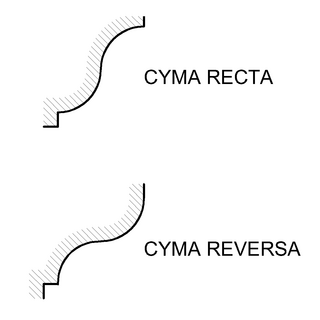
An ogee ( ) is the name given to objects, elements, and curves—often seen in architecture and building trades—that have been variously described as serpentine-, extended S-, or sigmoid-shaped. Ogees consist of a "double curve", the combination of two semicircular curves or arcs that, as a result of a point of inflection from concave to convex or vice versa, have ends of the overall curve that point in opposite directions.

Moulding, also known as coving(United Kingdom, Australia), is a strip of material with various profiles used to cover transitions between surfaces or for decoration. It is traditionally made from solid milled wood or plaster, but may be of plastic or reformed wood. In classical architecture and sculpture, the molding is often carved in marble or other stones.

Agrochola circellaris, The Brick, is a species of moth of the family Noctuidae. It is distributed throughout most of Europe, Asia Minor and Armenia.

Ovolo, an architectural and design term for a fundamental element of ornamental, architectural molding, as presented in the 1911 edition of Encyclopædia Britannica, was:
adapted from Ital. uovolo, diminutive of uovo, an egg; other foreign equivalents are Fr. ove, échine, quart de rond; Lat. echinus... [as used] in architecture, [for] a convex moulding known also as the echinus, which in Classic architecture was invariably carved with the egg and tongue. In Roman and Italian work the moulding is called by workmen a quarter round.

Trionychia is a superfamily of turtles which encompasses the species that are commonly referred to as softshelled turtles as well as some others. They are found throughout the temperate regions of the world. The Jurassic genus Sinaspideretes is considered the earliest representative of the superfamily.
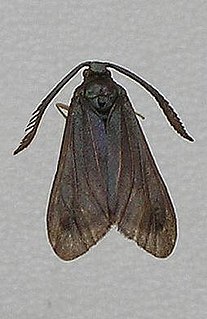
The levuana moth is an extinct species of moth in the family Zygaenidae. It is monotypic within the genus Levuana.
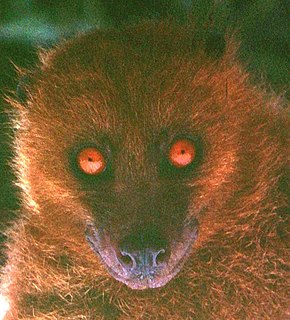
The Fijian monkey-faced bat or Fijian flying fox is a megabat endemic to Fiji. It was discovered in old-growth cloud forest on Des Vœux Peak, the second highest mountain peak on the island of Taveuni by William and Ruth Beckon in 1976, and is Fiji's only endemic mammal. It has recently been transferred from Pteralopex to its own monotypic genus Mirimiri.
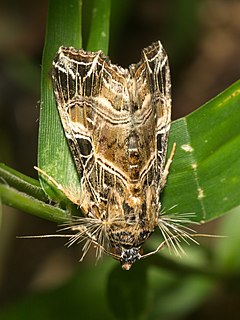
Callopistria rivularis is a species of moth of the family Noctuidae. It is found from the Indo-Australian tropics of India, Sri Lanka up to the Solomon islands and Fiji.

Anatrachyntis is a genus of moths in the family Cosmopterigidae. Some authors include it in Pyroderces.
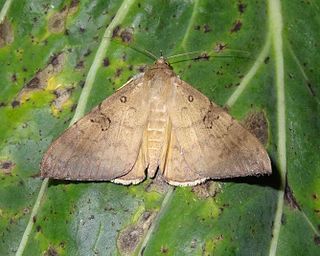
Oxyodes scrobiculata, the longan semi-looper or longan leaf-eating looper, is a moth of the family Erebidae. The common name "looper" is used despite looper moths generally being in the family Geometridae. The species was first described by Johan Christian Fabricius in 1775. It is found from the Indo-Australian tropics of India, Sri Lanka, Myanmar, China, east to Guam, Queensland, New Caledonia, Fiji, Samoa and Tonga.
Campbellana is a genus of moths of the Carposinidae family, containing only one species, Campbellana attenuata. This species is endemic to the Campbell Islands of New Zealand.
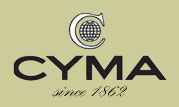
Cyma SA is a Swiss manufacturer of luxury wristwatches, founded by brothers Joseph and Theodore Schwob in 1862. By 1908, Cyma was advertising the resilience of their timepieces when exposed to electricity, magnetism and varying temperatures. The company is currently owned by Stelux International, Ltd. a Hong Kong-based holdings firm which invests primarily in fine jewellery and watches, and is overseen by fellow Fédération de L'industrie Horlogère Suisse member Universal Genève.

Simplicia cornicalis is a litter moth of the family Erebidae. The species was first described by Johan Christian Fabricius in 1794. It is found in south-eastern Asia and the Pacific. Records include New Caledonia, Réunion, Thailand, Fiji, Hawaii, India, Sri Lanka, the Society Islands, as well as New South Wales and Queensland in Australia. It is an introduced species in southern Florida and Louisiana in the United States.

Eublemma cochylioides, the pink-barred eublemma, is a species of moth of the family Erebidae described by Achille Guenée in 1852.

Serrodes campana is a species of moth of the family Erebidae first described by Achille Guenée in 1852. It is found from the Indo-Australian tropics to eastern Australia, Fiji, Samoa and New Caledonia. It is also present in Japan, Korea and Sri Lanka. The adult is a fruit piercer, but also feeds on flower nectar.
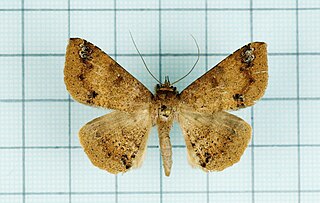
Ericeia inangulata, the sober tabby, is a moth in the family Erebidae. The species was first described by Achille Guenée in 1852. It is found in the Indo-Australian tropics of China, India, Sri Lanka, Myanmar, and the Marianas and Carolines, Fiji, Vanuatu, New Caledonia and Samoa.

Athetis reclusa is a moth of the family Noctuidae first described by Francis Walker in 1862. It is found from Sundaland to New Caledonia and Fiji. The habitat consists of open areas from sea level up to 1,200 meters.
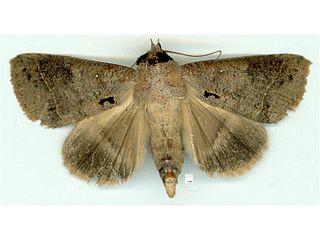
Pantydia metaspila is a species of moth of the family Erebidae first described by Francis Walker in 1858. It is found in China, Japan (Ryukyus), India (Maharashtra), Thailand, Taiwan, the Maledives, Sri Lanka, the Philippines, Borneo, Sumatra, Sulawesi, the Tanimbar Islands, Seram, Papua New Guinea, the Caroline Islands, the Solomon Islands, Vanuatu, Fiji, as well as Australia, where it has been recorded from Queensland.
Nites betulella, the black-dotted birch leaftier moth, is a moth in the family Depressariidae. It was described by August Busck in 1902. It is found in North America, where it has been recorded from Nova Scotia, southern Canada, the north-eastern United States, British Columbia and Wisconsin.
Myconita lipara is a moth in the family Gelechiidae. It was described by John David Bradley in 1953. It is found in Fiji.















